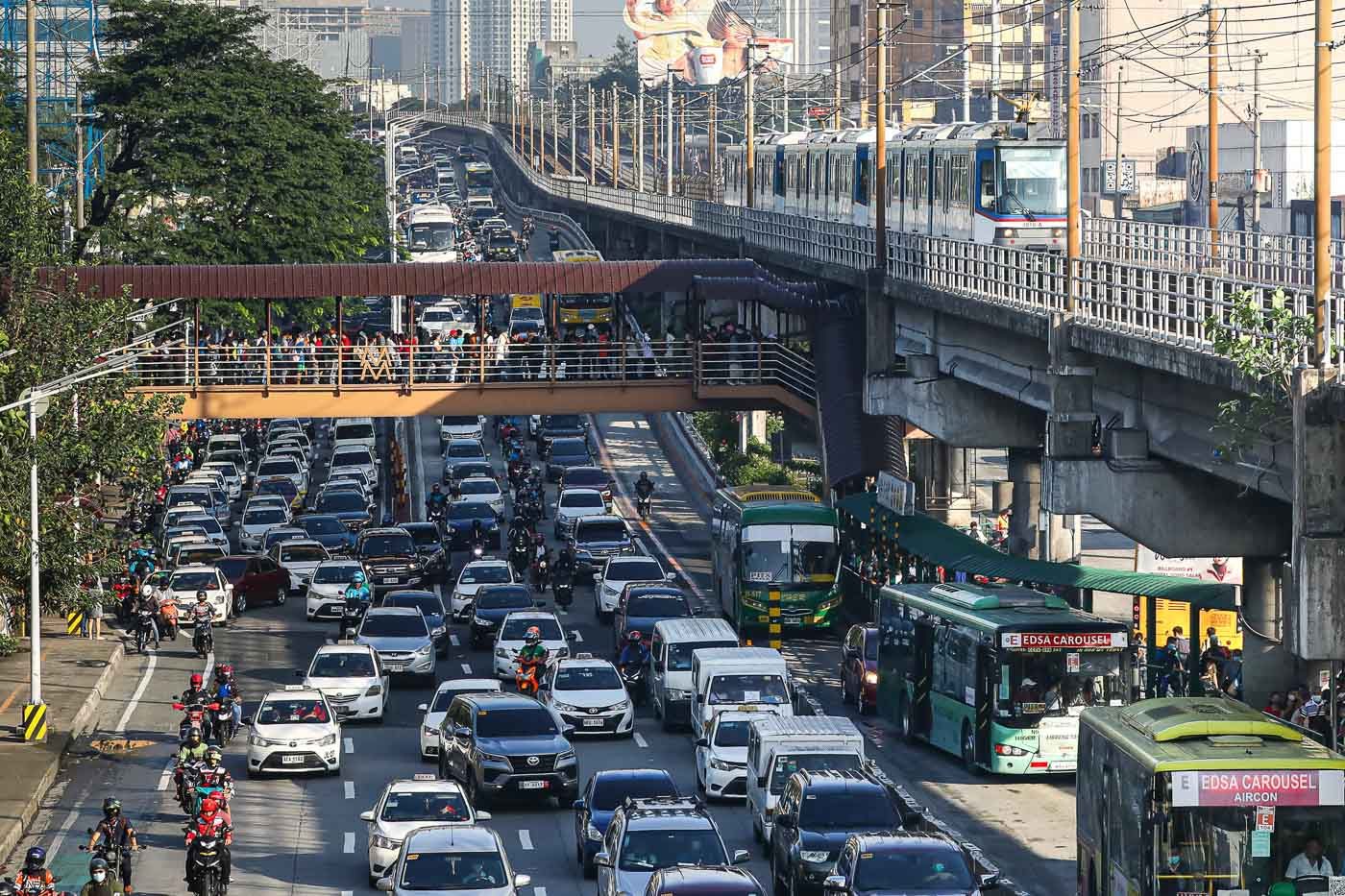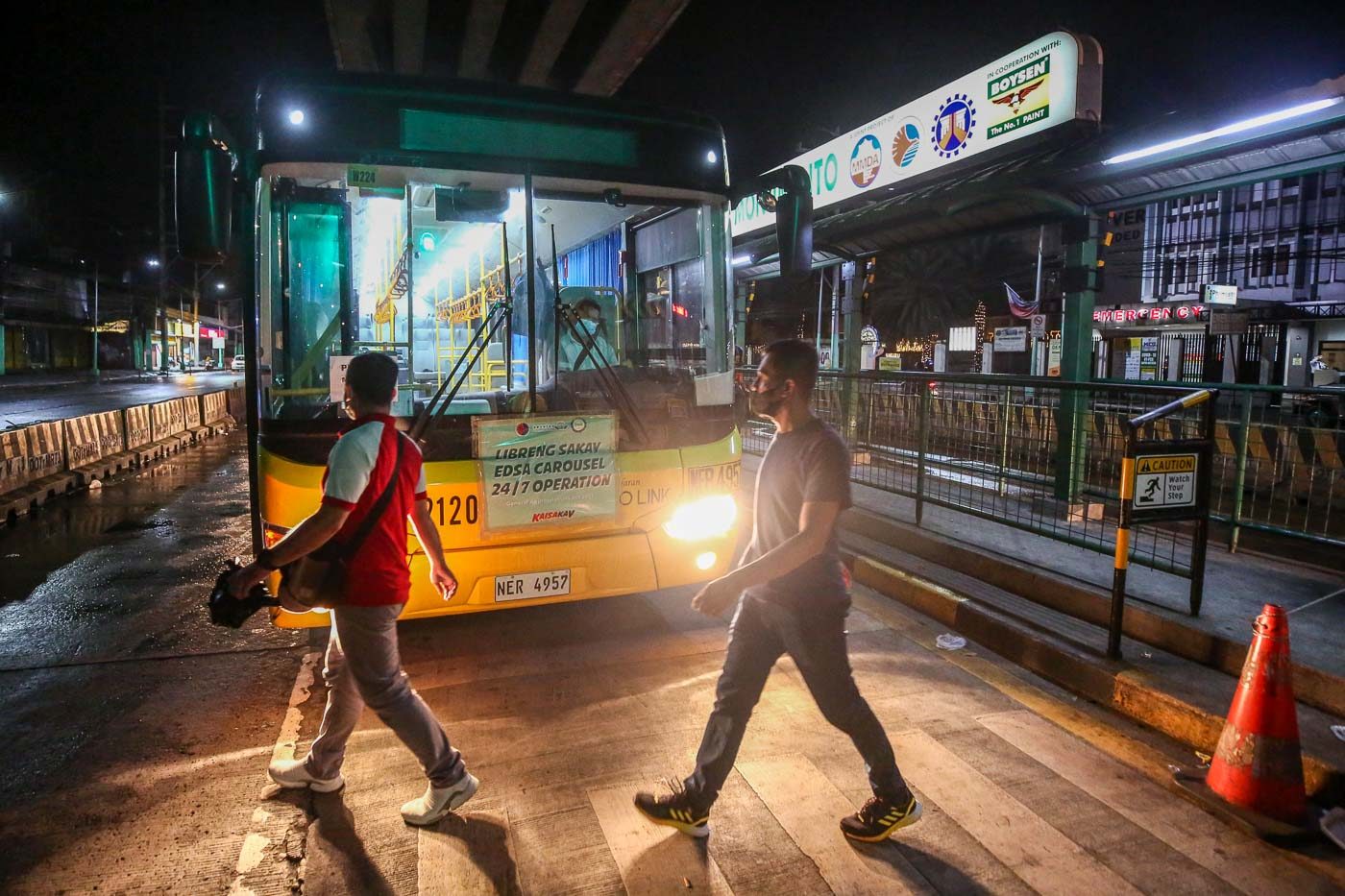You may have tried commuting via the EDSA Carousel and realized one could coast on the road during rush hours.
But like much of what makes up urban life in the Philippines, the bus system still leaves a lot to be desired.
Getting to some stations is not straightforward, requiring the commuter to go up and down flights of stairs just to wait in long queues. Stations are not weather-proof and passengers are left exposed during the hottest parts of the day or when there is heavy rainfall.
While the EDSA Carousel is not yet considered a bus rapid transit system (BRT), it has shown what fixing bus systems could mean for the riding public.
“It shouldn’t be, ‘The system works just fine, it’s good enough for Filipinos,” transport economist Robert Siy Jr. told Rappler in a mix of Filipino and English.
“We should make it as high quality and safe and convenient as we can because we want to make public transport an attractive alternative to using a private car.”
Turning the EDSA Carousel into a full-blown BRT would mean faster, more frequent and more reliable buses. Even so, it is already servicing millions of passengers per month, hitting 35 million passengers from January to July this year.
It has taken a long time before any action was taken to modernize buses. There are no BRTs in the Philippines yet, but plans are underway.
The Cebu BRT is currently built along Osmeña Boulevard. Over at Cavite, the local government is in talks with private firms to develop a BRT linked to the Parañaque Integrated Terminal Exchange.
The Bases Conversion and Development Authority targets to operate a BRT connecting Pampanga and Tarlac by 2027. In Manila, the Department of Transportation has announced its intention to open solicited bidding for the EDSA Busway project in 2025. Down south, a bus system similar to the EDSA Carousel will soon be set up in Davao City.

How it could work
Before the pandemic, when the EDSA Carousel was put up, passengers had to wait on the side of the road for buses. Or else ride the Metro Rail Transit Line 3, or MRT, infamous for its breakdowns, congestion, and long queues.
A BRT, similar to the project that the Cavite local government is pursuing, could be operated by private firms that have long-term performance contracts.
This setup would ideally put service at the forefront: buses follow a strict schedule, they arrive at determined intervals.
“It’s very precise,” said Siy. “And there are penalties if the buses do not run according to the schedule. Because it’s in a dedicated lane, there’s no more traffic.”

There are some basic features, identified by the Institute for Transportation and Development Policy (ITDP), that need to be followed before one can pass as a BRT.
There should be dedicated lanes, situated at the center of the road, where buses can go unimpeded by traffic. Fares are collected before boarding. At intersections, making turns that go across the bus lanes is prohibited. The station and the bus entrance/exit should be at level with each other, to make boarding quicker, safer, and more inclusive even for the disabled.
Aside from these basics, government and private firms can zero in on other specifications that would create a better commuting experience: having passing lanes so there can be express services, fewer stops and bigger capacity, using fully electric or hybrid buses to minimize emissions, having doors on either side of the bus, and establishing bike parkings in stations.
The point is: everything should be fast, on the dot, and universal.
As the system expands more buses from outside the city could be integrated into the main trunkline. This is crucial as commuters come in from neighboring towns and provinces outside Metro Manila, other urban areas, or central business districts.
Understandably, there is a need to localize designs.
Nigel Paul Villarete, former Cebu City administrator and project manager of Cebu BRT, said that standards from the ITDP are good, but don’t necessarily mean they should be followed to a tee.
“Cebu BRT may follow them whenever applicable and feasible, but not when not,” Villarete told Rappler.
I believe the designs evolve and should follow the local needs and requirements and adjust to the local mindset.”
The BRT in Cebu was conceptualized as early as the 2000s, said Villarete, when former Cebu mayor Tommy Osmeña visited Curitiba, Brazil, and Bogota, Colombia — pioneers of the BRT system. The BRTs in these cities had spawned duplicates across the world. It might also be of interest to some people that these two BRT systems were led by mayors.
“It needs political will, a lot of enforcement of imminent domain, and investments of not less than $10 million for every kilometer to solve mobility and to have roads that are safe for children, the elderly, and the poor,” former Bogota mayor and BRT pioneer Enrique Peñalosa said of Cebu’s BRT, way back in 2009, according to a Philippine Star report.

Better than the old system
Buses have long been plying our roads since post-World War II.
While they have bigger capacity than other forms of public transport such as jeepneys or the UV Express, buses have not been as popular as rail, for example, as they get stuck in traffic, alongside private vehicles.
In the past, drivers of buses had to meet the “boundary” system. They would overtake other buses to board more passengers and would wait even in stops not designated for buses. This made bus-riding unsafe and travel times longer than necessary.
Reyma Santiago, who had been using the EDSA Carousel to get to work, said that while there are many things to be frustrated with in the current bus system, it was better than the old one.
“I like the system now because there are designated stops,” Santiago told Rappler in Filipino. “And someone is manning the stops: when the bus will board passengers, when the bus will leave the station. Before, buses just stopped wherever. There were waiting areas but they unloaded passengers randomly. They contributed to traffic.”
Santiago, 40, rides a bus at the Bagong Barrio station at 5:30 am and alights at Guadalupe station by 6:30.
The EDSA carousel has been her primary mode of transport going to work for over a year now. Sometimes, she said, travel time takes longer because of queues of both buses and people in certain stations.
But she sticks with it, as it’s more efficient.

“When I go home, it’s during rush hour,” said Santiago. “The buses in the bus lane are moving, then you’ll see private cars in other lanes stopped or moving very slowly.”
That’s why it had been especially vexing for her when a politician recently hit the bus lane on EDSA.
“Ilang bus lang ang gumagamit ng bus lane, bakit hindi buksan during heavy traffic para mas lumuwag ang traffic?” Leyte Representative Richard Gomez posted on Facebook last August, saying he had been stuck in traffic for two hours.
(Only a few buses use the bus lane, why don’t we open up the bus lane during heavy traffic to ease traffic flow?)
This is a common criticism of busways or BRTs — their need to take up space on the already congested roads in cities. This is also a point raised whenever comparisons between BRTs and rail systems are made.
“For me, you have the privilege, the comfort of having a private car,” Santiago said. “You’re comfortable. Meanwhile, commuters have to contend with the crowd, go up and down the station. Give this to us. At the same time it’s good for all: many people could ride via that system compared to few people in cars.”
There had been plans to create a Metro Manila Bus Rapid Transit system before. The P37.7-billion project was approved by the National Economic and Development Authority Board back in September 2016.
In a nutshell, it was supposed to serve 1.6 million to over 2.5 million riders per day with 63 stations from Monumento up to the Ninoy Aquino International Airport.
The project was eventually scrapped. Concerns then, according to Siy, were not having enough demand due to other rail projects, difficulty of implementation, and bus operators’ willingness to consolidate.
For Siy, rail and the BRT should not be mutually exclusive.
“It shouldn’t be either or,” said Siy. “Oftentimes people look at rail, ‘There’s the MRT, let’s just improve that.’ For me we need to develop rail and bus as complementary because very few people live very close to the rail line.”
Other countries that implemented the BRT also found that it required lower investment than rail projects.
BRT can be a green system
An efficient bus system with a fleet of electric buses would considerably reduce emissions and make cities more livable.
In 2020, the transport sector accounted for 14% of the country’s total greenhouse gas emissions. And emissions from transport in the Philippines are set to get even bigger, quadrupling by 2050, according to a 2022 report from the World Bank.
If it’s bound to expand, all the more that it has to be fueled sustainably.

“Within the framework of sustainable transport’s avoid-shift-improve approach, BRT contributes to a low carbon transport system by helping individuals to shift to more energy efficient transport systems wherein more people can be moved using lesser fuel and lesser road space occupied,” Golda Hilario, director at policy think tank Institute for Climate and Sustainable Cities, told Rappler.
According to Hilario, getting electric buses could increase start-up costs, but that this could be addressed by viable business models “either bulk purchasing through transport alliances…or vehicle leading models via public-private partnerships.”
When one talks about the green transition now, one inevitably talks about scale.
In India, electric buses were deployed on roads after the government aggregated demand across cities and procured electric buses at cost 23-27% lower than those fueled by diesel and compressed natural gas.
After the electric buses are procured, the private sector operates the buses to ensure quality of service, said Mahua Acharya, former CEO of publicly-owned company Convergence Energy Services Limited, which led the electric bus deployment in India.
“Release them back to the city on a service model,” Acharya told Rappler in an energy finance conference. “Let a private operator come and give you the service.”
The government’s job, said Acharya, is to make sure they make payments on time (per-kilometer fee paid to the private operator) and penalize those that don’t perform.
This would work if the government recognizes that it is their “imperative” to provide transport. Otherwise the private operator will “only go up and down the routes that have the most traffic,” Acharya said. – Rappler.com
Quotes are translated to English for brevity.



































